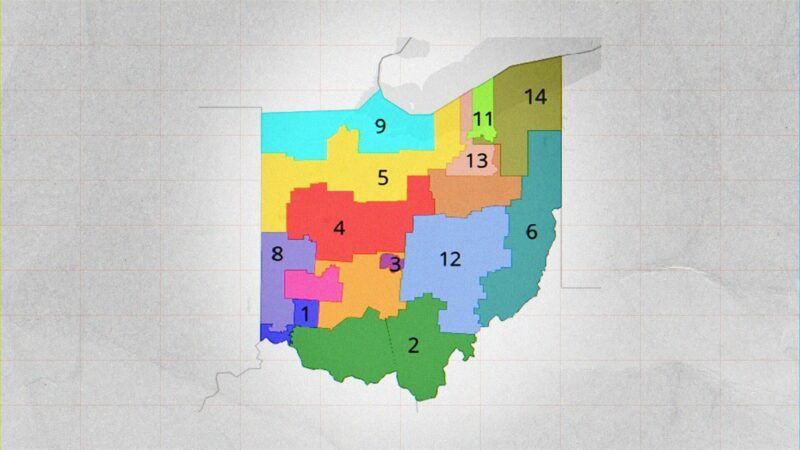Did Redistricting Reform Fail in Ohio?
Ohio's supposed reforms left lawmakers in charge of the mapmaking process, and a gerrymandered map was the predictable result.

After Republicans used their control of Ohio's state government to draw politically favorable congressional and legislative district maps a decade ago, voters in the state approved a constitutional amendment in 2018 that was supposed to put an end to such single-party mapmaking.
It seems to have failed.
In a pair of rulings last week, the Ohio Supreme Court rejected the proposed maps—congressional, state Senate, and state House district—on the grounds that all three unfairly favored Republicans. "The General Assembly produced a plan that is infused with undue partisan bias and that is incomprehensibly more extremely biased than the 2011 plan that it replaced," wrote Justice Michael Donnelly in a 4-3 opinion invalidating the new congressional plan.
The proposed congressional map would have given Republicans an advantage in 12 of the state's 15 congressional districts, according to an analysis by the Princeton Gerrymandering Project, which measures proposed and enacted political maps on several different metrics of geographic compactness and political competitiveness. (At present, Republicans control 12 of the state's 16 congressional seats, but Ohio is losing one seat due to reapportionment.)
Though the proposed map scored a grade of "C" for compactness and for not unnecessarily dividing too many existing political boundaries, the Princeton Gerrymandering Project gave it an overall grade of "F" for the underlying partisan imbalance. A fairer map, the group says, would give Republicans an edge in eight to 10 of the 15 districts.
It's not exactly clear what will happen now, but The Columbus Dispatch reports today that both the state legislature and the state's new redistricting commission will get back to work on a new set of maps.
Rather than speculating about what might happen next, it's more useful to look back at how Ohio arrived at this point. What went wrong with the redistricting reforms that were supposed to prevent this one-sided outcome in the first place?
The answer has to do with the changes implemented in 2018, which ultimately left state lawmakers and other political figures in control of the process, despite the veneer of reform. The constitutional amendment approved by voters created a new redistricting commission for redrawing state House and state Senate districts but left the state's General Assembly in charge of the congressional district-drawing process—though the amendment did raise the threshold for passing a new map so that 60 percent of both chambers had to approve.
That explains why the congressional map ended up the way it did. Republicans hold sizable majorities in both chambers of the Ohio General Assembly, so they easily passed a map that was slanted towards the GOP.
But the commission failed to draw a map that could pass judicial muster. That's probably because, unlike some other states that have attempted to create commissions where members of the public have a say, Ohio's "reform" put seven high-ranking state officials in charge of the legislative maps. The commission's members are: Gov. Mike DeWine (R), Secretary of State Frank LaRose (R), State Auditor Keith Faber (R), Speaker of the House Robert Cupp (R), Senate President Matthew Huffman (R), House Minority Leader Emilia Sykes (D), and state Sen. Vernon Sykes (D).
That means Ohio's new (and newly rejected) district maps are a classic example of what Walter Olson, a senior fellow at the Cato Institute, has previously termed "buddymandering." It's one of the major reasons why some redistricting reforms "go off the rails," as Olson wrote in a July 2020 Reason article. Leave politicians in full control of the redistricting process and overtly political outcomes are sure to follow.
There is probably no set of reforms that can fully remove politics from what is an inherently political process. Politicians and political parties have extremely powerful incentives to influence the district-drawing process, so the key is to try and mute that potential influence as much as possible—or, at the very least, to prevent one party from having full control. In the same way that effective constitutions prevent power from accumulating in a few hands, an effective redistricting system is one that diffuses the responsibility away from those who have the strongest desire to control it.
Many states have undertaken reforms—of varying degrees of effectiveness—over the past 10 years, so this redistricting cycle is the first large-scale experiment with what works and what doesn't. Clearly, Ohio's tepid changes were not worth much.
But reforms in other states still offer hope. In Maryland, for example, a truly nonpartisan citizens redistricting commission produced a congressional map that is objectively superior in every way to the one produced by state lawmakers. Unfortunately, the lawmakers get to choose which map becomes reality—something that reformers will try to fix before 2030.
Reformers in Ohio might want to pay attention to the words of Chief Justice Maureen O'Connor of the Ohio Supreme Court. A Republican appointee, O'Connor joined with the court's three Democratic appointees to block the approval of the new state legislative district maps. In a separate concurrence, she highlighted the obvious benefits of nonpartisan redistricting commissions.
"While not free from their own vulnerabilities, independent redistricting commissions have become 'the premier institutional solution to the problem of partisan gerrymandering' because they increase the degree of separation between map-drawers and partisan politics," O'Connor wrote. "Having now seen firsthand the current Ohio Redistricting Commission—comprised of statewide elected officials and partisan legislators—is seemingly unwilling to put aside partisan concerns as directed by the people's vote, Ohioans may opt to pursue further constitutional amendment to replace the current commission with a truly independent, nonpartisan commission that more effectively distances the redistricting process from partisan politics."


Show Comments (71)